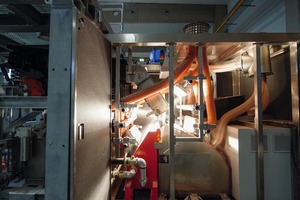New freefall sorting installation for sorting waste materials
Up to now, only few cases are known in which sensor-assisted sorting installations are used in the recycling of waste materials. Examples can be found in Germany, Switzerland or Spain. Either colour line cameras are used to recover, for example, clay bricks from mineral-based construction and demolition waste or NIR cameras are operated for the removal of foreign materials and impurities as well as for sorting. With neither of these two variants on their own is it possible to recover unmixed construction material fractions.
On account of the increasingly complex composition of building structures, new technologies are needed with which unmixed and impurity-free products can be recovered. In particular, gypsum particles can only be detected with a NIR camera and removed from the product flow. Detection of gypsum in a composite building material, e.g. gypsum plaster on a wall building material, is only possible if all sides of the particles are scanned.
Development of a robust freefall sorting installation for stationary application
Working in cooperation with the IAB- Institut für Angewandte Bauforschung Weimar gGmbH, Optosort set itself the task of developing a robust freefall sorting installation for the separation of mineral construction and demolition waste and the removal of impurities (gypsum, bitumen, tar, plastics, etc.). With a combination of hyperspectral near-infrared technology and colour detection as well as simultaneous “observation” of all particle surfaces, current and/or expected recyclables and/or impurities can be detected and sorted with a high recovery rate. Sorting of the construction and demolition waste is the precondition for closed material cycles in the construction industry.
To date, a freefall sorting installation with a combination of detection systems and arrangement of the detectors on two sides of the falling construction rubble particles has not been available worldwide. But with such an installation, the disadvantages of the two individual technologies can be balanced out (Fig. 1).
The freefall sorting installation is equipped with coupled RGB line cameras and hyperspectral NIR line cameras, arranged on two sides of the material stream. Focus is on the following key functions:
Detection of dry and wet mineral particles
Scanning of all particle surfaces
Reliable ejection of the detected impurities
Robustness and low-wear when exposed to abrasion by mineral particles
Flexibility, for mobile operation, too
Suitable for particles between 10 mm and 100 mm
Low-maintenance and automatic white balance in continuous operation
Low energy consumption, selective control of the particle discharge with compressed air pulses
Integration in local networks (LAN) or modem
Before the material is detected and sorted in freefall so the impurities can be removed, it is distributed on a vibrofeeder over the entire width of the installation and accelerated on a chute (Figs. 2 – 5).
In the scope of research work conducted at the IAB, the limits of application have been tested and general correlations derived (particle size, colour, NIR spectrum, surface properties of the particles, like, for example, texture, dust stuck to their surface). The chemical-mineralogical compositions of the building materials should be correlated with the spectra. The results obtained form the basis to realize more selective and effective sorting of demolition rubble so as to open up new recycling options for the secondary resources produced.
As investigations so far show, mineral construction materials can be clearly identified based on their colour in the range of visible light, however, on account of colour overlap between different mineral building materials it is not possible to differentiate between these and sort them accurately. If only colour detection is applied, frequent misdetection and misclassification occur. Impurities of different types but with the same colour cannot be separated from each other. Only building materials with unique colour features, like clay bricks and concrete, can be separated.
In the NIR range, fewer misdetections occur although some special materials sometimes deliver unsatisfactory spectra. Not identified are glass (amorphous) and very absorbent materials, like roofing felt or bituminous materials. The highest detection rates are achieved for wood, gypsum and aerated concrete. The latter make up the impurity fractions that most urgently need to be removed from the product.
The goal of the development is to increase the detection rates for the individual materials, especially with regard to the spectral processing and validation. With the use of object detection – integrated in the sorting software, it is also possible to detect and remove composite particles with foreign and impurities stuck to them.
With a stationary freefall sorting installation, up to 20 tonnes construction rubble per hour with particle sizes larger than 10 mm can be sorted. Fig. 6 shows the freefall sorting installation, with its very robust design, which can also be used for the separation of plastic mixes and waste glass.
In November 2019, at the IAB Recycling Testing Centre, the freefall sorting machine was commissioned and successfully trialled (Figs. 7 – 10). The innovative sorting technology is now available for various sorting applications in the scope of research projects and for use by industrial partners. The recycling test centre at the Institut für Angewandte Bauforschung Weimar gGmbH, IAB is equipped with crushers, mills, screens, pan granulators and different rotary furnaces so that here extensive projects can be carried out, centring on recycling and the development of new materials derived from waste materials (Fig. 10).
Markus Eck, Head of Sales, OptoSort GmbH;
Dr.-Ing. Barbara Leydolph, Head of Research Department Building Materials, IAB - Institut für Angewandte Bauforschung Weimar gemeinnützige GmbH;















